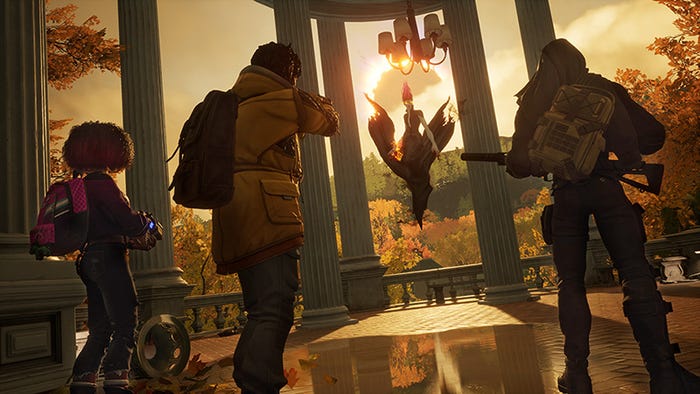
Featured Blog | This community-written post highlights the best of what the game industry has to offer. Read more like it on the Game Developer Blogs.
Android Marketing for Indies
For my second Android game launch, I went through a crash course in indie games PR and marketing. Here is what I learned!

Seeing a game through the finish line is one of the most important milestones in game development. Finally, after months (or years!) of effort, the game is out the door and ready to be played by millions of gamers all over the world… or so it seems.
As many of you know – or will painfully learn - your job isn't finished with the game going gold. You still need to tell the world that your masterpiece actually exists!
I've gone through this process with two Android games, FRG and ErnCon, and would like to share my experiences (from a marketing point of view) with Gamasutra readers.
But first … Why I chose Android instead of iOS
In 2009, I was developing FRG as a standalone desktop game written in Pascal. The Android Developer Challenge 2 was announced and I saw a unique opportunity to do something cool with my brand new G1. Since I am a Java developer by trade, porting what little I had written to Android was easy. Furthermore: FRG became an ADC2 finalist, making me proud of my “baby” and I received two free Motorola Droids from Google, one for being a finalist and another phone for having a semi-popular game in the early days of the Android Market (now Google Play).

ErnCon concept art
ErnCon Concept Art
FRG
When FRG was launched in 2009, there wasn't much to announce. All I did was post on the android-discuss newsgroup, forums like androidforums.com and java-gaming.org, and that was it. Proud as I was of FRG's ADC2 performance, ADC2 did not cause a noticeable increase in downloads. Like most indie game-dev efforts, FRG was developed with a small budget so significant marketing spend was impossible. Android game-review websites were popping up but most were small and attempted to collect review fees from developers. I ended up paying $25 for one review which did not seem to drive any downloads, for example. The reviewer also purchased FRG Deluxe, did the review, and then refunded her purchase!

FRG
FRG
How did FRG gain any sort of traction? Back in the dark ages, the “Recently Updated” list in Android Market was a useful tool to gain exposure for the cash-strapped developer. There were enough bugs and enhancements to make that I was able to release an update for FRG every 1 or 2 weeks for over a year. Each update yielded about 700 downloads each week with about half of those keeping FRG on their phones. Unfortunately as I ran out of things to fix, updates to FRG slowed down and user retention started to slip.
There were a couple noteworthy events afterwards:
Being listed in T-Mobile's Top Picks list for 2 weeks brought about 400-500 downloads per day.
FRG Deluxe was Free App of The Day in the Amazon App Store around August 2010. It was downloaded about 88,000 times and even earned me about $400 in purchases the day after. Note that Android Market downloads were NOT affected at all by being Free App of The Day.
ErnCon
Fast forward to January 2012 when my newest game, ErnCon is under development and 2 months away from expected release. I made the decision to hire a PR professional and found Novy PR.
The decision to seek outside help was driven by the following:
Time – Although I hired contractors to complete artwork and music, I was the only person putting his own time into ErnCon making it mostly a solo project. I am also happily employed full time; after getting home from work, I typically spent the rest of my weeknight working on ErnCon. Weekends were almost completely devoted to ErnCon. With the game still under development, I did not have time to draft and send out press releases or contact game-review websites.
Money – I had been putting money aside for a while to develop ErnCon and when graphics and sound came in under budget, I realized I had enough to hire an actual professional to work on PR.
Removal of “Recently Updated” list in Google Play – Google removed the “Recently Updated” list in 2011 with good reason. It was too easy to abuse. Given the number of new apps and games coming out these days, this sort of feature is just not useful for consumers.
Expertise and specialization – I knew I was already behind on the PR front. Doing the entire launch by myself would only cause ErnCon to launch poorly as I learned the ropes – I didn't really learn anything about PR with FRG since I relied so heavily on “Recently Updated” as my primary user acquisition strategy. An expert was needed to jump-start the process.

ErnCon
ErnCon
Pre-release and Public Beta
By the time I had gotten off my first phone call with Luis from Novy PR, I had already been steered away from stupid mistakes like launching during GDC or PAX East. The general pre-release plan we came up with went as follows:
Find beta-testers for a private beta to collect input and get the game in people's hands. Reddit (/r/Android) proved to be a useful place to ask for volunteers for the private beta. I ended up with over 60 signups from USA, Canada, and various European countries. Interacting with Redditors also convinced me to support Canada and all of Europe.
Create a trailer for the media and potential players to see before trying the game. Even though ErnCon is a free download, a trailer still helps to show your game at its best. I had not even considered creating a trailer for ErnCon thinking it was too much trouble. Luis insisted that it is an essential part of any game's launch and provided important feedback as I put the trailer together.
Improve the Woo Games website to give visitors a good impression of Woo Games and ErnCon. It's amazing how sloppy I was with the original Woo Games website using an old default Nucleus CMS theme. Switching to WordPress, creating a tasteful logo, and listening to feedback from Luis went a long way towards presenting a professional face to the world.
Release a public beta 1 month before launch. Luis would pitch Android websites to cover the public beta of ErnCon. A public beta of a multiplayer internet game such as ErnCon is newsworthy and allows me a relatively low-risk way to iron out any final problems in the game before official release.
ErnCon's public beta was announced on February 28th. Coverage of the public beta occurred over the next few days and brought in over a thousand active installs. The trailer itself became a point of contact with players as it was embedded and linked to from various websites. Coverage also reached an international level with French, Italian, and even Chinese Android websites covering the beta. This was great for the beta as it gave me the volume of users needed to test ErnCon's multiplayer architecture. Bugs were found and fixed, the game was adjusted based on user feedback - I was pumped for the actual launch.

Droid Gamers Coverage
Droid Gamers Coverage
Ready, Set, Go!
ErnCon was launched 3 weeks after the public beta was announced. A press release was sent over Business Wire while Luis began pitching Android websites again. Coverage was about the same as the public beta netting another 1000+ active installs in a few days. Unfortunately Luis and I noticed an odd phenomenon where the public beta generated more coverage than the official launch! Regardless, coverage from sites like droidgamers.com, androidpolice.com, and frandroid.com were instrumental in driving downloads for the launch. Interestingly, FrAndroid – based in France – brought the most active installs to ErnCon.

FrAndroid Coverage
FrAndroid Coverage
As happy as I was with the coverage ErnCon received since the public beta, I was disappointed with the overall numbers of the launch itself. When looking back, there were some interesting circumstances that may have affected coverage both the public beta and the launch:
February was a great month for shmups – by the end of February Shogun, Neoteria, and ErnCon were announced for Android. Media websites lumped the three together in their end-of-month coverage and players had a great range classic-style shoot’em ups to play.
Public betas for Android – public betas of games on Android are uncommon enough that announcing one might be interesting to a journalist.
March was a great month for big announcements – March 21st was chosen as the official release date of ErnCon to take advantage of the post-GDC lull in game news. Other developers were thinking the same as March saw news from many high-profile mobile games. Taken together, these announcements would keep any journalist busy:
Angry Birds Space – although Angry Birds was released a day after ErnCon, I don't think this hurt ErnCon as much as you may think. Although most websites covered Angry Birds, coverage wasn't 100 percent Angry Birds all day every day. ErnCon was also lumped in some end-of-week game lists with Angry Birds Space.
Draw Something – Draw Something became a “thing” with the media during March with subsequent acquisition by Zynga.
Humble Bundle for Android 2 – any Humble Bundle is worth checking out for quality indie games. The announcement of the second Android bundle included some highly anticipated ports of iOS games like Canabalt.
Android news websites don't cover games – there are very few Android-centric gaming websites. Droid Gamers is probably the biggest Android-only gaming website and they were quite happy to cover both ErnCon's beta and release. There doesn't seem to be an Android equivalent to Touch Arcade that is the definitive Android game review site. Most Android news websites seem concerned with the latest Android hardware, custom ROMs, non-game applications, and ports of notable iOS games.

Android Police Coverage
Android Police Coverage
Lessons Learned
Launching ErnCon forced me to learn a lot about games PR and marketing. Many good things also happened as a result:
ErnCon has a great trailer – an entire blog post could be written describing the things I learned putting together the ErnCon trailer. When posted on YouTube and linked from ErnCon's Google Play page and various review sites, the trailer acts as an ever-playing commercial to attract players. When a website embeds your trailer, you can also use it to gauge how much interest that website is driving by looking at the breakdown of views by source.
Websites reporting on your game result in motivated users – After the launch, I started a Tapjoy Rewarded Installs campaign that drives about 400-500 downloads but only 100-200 active installs per day. The public beta and launch announcements drove about 4500 downloads with about 2500 active installs. According to my Google Analytics tracking, Tapjoy players engage less than the players who installed ErnCon during launch. This is probably because most are just looking to collect their Tapjoy rewards.
Quality results when searching for ErnCon – searching for “ErnCon” on Google returns relevant results pointing to ErnCon reviews and ErnCon's Google Play page. Prior to public beta, searching for “ErnCon” would cause Google to think you were searching for “enercon”.
Ultimately the experience was worth it. With some professional help, I was able to jumpstart a user-base for ErnCon that I can cultivate into something great especially given how important a thriving user-base is for a multiplayer game.
Hopefully this post will help you understand some of the (many) challenges in marketing your Android game. Feel free to leave a comment here on Gamasutra or via email at [email protected].
Read more about:
Featured BlogsAbout the Author(s)
You May Also Like













